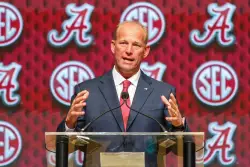DC officials defend policies to treat homeless people as White House seeks different direction
Hours after President Donald Trump signed an executive order Thursday that dramatically changes the way he wants states and cities to treat homelessness, D.C. officials are defending their programs that assist the city’s homeless population. D.C.’s new acting director of the Department of Human Services, Rachel Pierre, pointed to a 9% year-over-year decline in overall homelessness in the city as one of several areas where the District is making significant progress. But now, the White House is indicating it wants local governments to go in a much different direction. “We have a responsibility to track what’s happening on the federal level and in the White House. However, I can tell you that the mayor has very much always stated that she believes in that the best interest for our residents is to come inside. So, what we do is make sure that we have outreach to talk to our residents and help connect them to interventions that work for them,” Pierre said. Pierre told WTOP that when D.C. did its annual headcount of the homeless population in January, the number of unsheltered people was declining across all categories. City officials are declining to get into a point-by-point with the White House over the new policies it wants carried out, instead insisting its long-term and short-term policies are working. “The mayor has been very committed in ensuring that homelessness is a top priority. That’s been evident in the past 10 years, and even with the District’s financial situation, she continues to invest in interventions that work,” Pierre said. “We are leveraging and building on everything that the mayor has done to improve homelessness in the past 10 years.” Some of those policies include targeting family and youth homelessness and providing more transitional and permanent housing. That also includes renovating and opening the new 100-bed Aston Bridge Shelter near George Washington University and plans are underway to open another 170-bed similar facility later this year. D.C. purchased the former GWU dorm in 2023 for $27.5 million and made significant renovations and upgrades, including a new HVAC system, to turn it into a shelter. The city said in its January report that 5,138 people were classified as not having a home and that 792 were unsheltered and living on the streets. Before leaving for Scotland on Friday, President Trump said the new executive order does take a different approach to the nation’s homelessness issue, but he insists his strategy is going to work. “Right outside, we have some tents, and they’re getting rid of them right now, you can’t do that — especially in Washington, D.C. I talk to the mayor about it all the time, I said you’ve to go get rid of the tents,” Trump said on the South Lawn on Thursday. “We can’t have it. When leaders come to see me to make a trade deal for billions and billions and even trillions of dollars, and they come in and there’s tents outside of the White House, we can’t have that. It doesn’t sound nice.” On Thursday, when the executive order was signed, White House press secretary Karoline Leavitt said in a statement that Trump was committed to “end homelessness across America.” “By removing vagrant criminals from our streets and redirecting resources toward substance abuse programs, the Trump Administration will ensure that Americans feel safe in their own communities and that individuals suffering from addiction or mental health struggles are able to get the help they need,” she wrote. The National Homeless Law Center, a D.C.-based advocacy group for the homeless, said in a statement it “strongly condemns today’s executive order, which deprives people of their basic rights and makes it harder to solve homelessness. This executive order is rooted in outdated, racist myths about homelessness and will undoubtedly make homelessness worse.” Source


